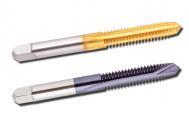All metal cutting tools and taps are comprised of four basic design features, each serving its own function to the overall quality of any given tool. Understanding these functions can be beneficial in ensuring that the best decision is made during your tool buying process.

1. The Cutting Face is the portion of the tap flute between the major and minor diameter of the thread that cuts or shears the workpiece material. Here’s how the two types of hooks work:
2. Relief on a threading tap may be found on the chamfer’s major diameter or in the threads. This feature — which is required for tapping — is typically in the form of radial clearance or back taper. Radial clearance or thread relief is a thinning of the tooth from the cutting face to the heel of the thread land to relieve cutting pressures and friction across the land of the tap. Thread relief is applied for materials that are tough, hard or have high elastic memory. Elastic memory applies to materials such as titanium which shrink or squeeze the tap, creating friction.
Back taper is the reduction of the major, pitch, and minor diameters from the first thread at the front of the tap to the last thread near the shank. While thread relief is applied for specific applications, back taper relief is applied to all threading taps.
3. The Base Material selected for the tap is based upon the workpiece material or the cutting conditions for tapping. Premium grade materials such as cobalt-based M42 or tungsten/vanadium based T15 powdered metal may be applied if the workpiece materials are hard, tough, or abrasive. These materials combat abrasion and are often heat resistant, allowing the tap to maintain the cutting edge longer.
General purpose high-speed steels such as M2 steel is adequate for most other workpiece materials such as soft steels and cast irons. Premium steels usually are required in all materials to withstand the heat and abrasive conditions when encountering higher RPMs or long production runs.
4. Surface Treatments are typically used to prevent wear resistance or help assist in lubricating the threading tap to allow the chips to flow from the workpiece. Each type of surface treatment, or coating, has its own advantages according to the workpiece material being used: